 | 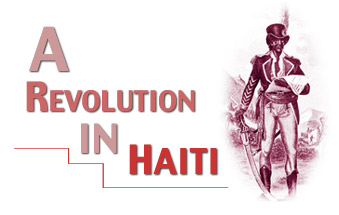
 |
The insurrection on the i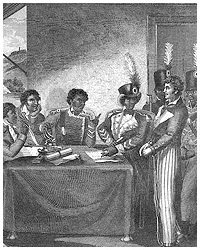 sland of San Domingo came from the mass of enslaved blacks in the French sugar plantation colony there, who risked everything to pursue freedom. In 1791, the outbreak of the Haitian Revolution, at first localized in one district of the colony’s northern plain, soon spawned waves of slave insurgencies that assembled and fought the horrors of oppression. Historical accounts written by white contemporaries downplayed the organization of the blacks, and proposed chaotic, random events by groups of revolting slaves as the cause of revolution. However, the resistance had leadership, organization, and a unifying objective. Their struggle lasted for twelve years, and became the only successful slave revolt in human history. sland of San Domingo came from the mass of enslaved blacks in the French sugar plantation colony there, who risked everything to pursue freedom. In 1791, the outbreak of the Haitian Revolution, at first localized in one district of the colony’s northern plain, soon spawned waves of slave insurgencies that assembled and fought the horrors of oppression. Historical accounts written by white contemporaries downplayed the organization of the blacks, and proposed chaotic, random events by groups of revolting slaves as the cause of revolution. However, the resistance had leadership, organization, and a unifying objective. Their struggle lasted for twelve years, and became the only successful slave revolt in human history.
Resistance acquired momentum as every slave undermined elements of planter authority. However, revolution and resistance became possible in San Domingo when slavery itself was challenged. The first French document to support this challenge was the Declaration of the Rights of Man. Passed in France on August 26, 1789, it states: "In the eyes of the law all citizens are equal." Article II states, " The aim of all political associations is the preservation of the natural rights of liberty, property, security, and resistance to oppression." St. Domingue was under French law, yet these rights had not been implemented at the outbreak of the Revolution on August 23, 1791. The Constituent Assembly of France and the colonists were too frightened of change to grant these rights to men and women of color. For one thing, the exploitation of the slaves for profit was a rewarding business. "On a sudden this society demands an Abolition of the Slave Trade; that is to say, that the profits, which may result from it to the French commerce, should be transferred to foreigners." On November 3,1791, the Deputies representing the National Assembly on the island of San Domingo stated, "The Society, say the Deputies, take hold of the Declaration of the Rights of Man: this immortal work, beneficial to enlightened men, but inapplicable, and therefore dangerous to our regulations, they send with profusion into our Colonies." According to Revolutionary French legislation, slaves should have been free. Nevertheless, fear and profit momentarily bound them to a lucrative business. Revolution was the only alternative.
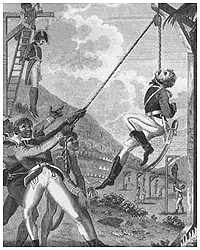 Some French Revolutionaries believed in the equality of all. This helped spread more anti slave messages around the island of San Domingo. The anti slavery sentiment was supported by the Amis des Noirs. In a speech made to the National Assembly they were accused of helping spread the message of abolition to the blacks on San Domingo. "The journals in their pay or under the influence, give the declaration vent in the midst of our gangs. The writings of the Amis des Noirs, openly announce, that the freedom of the Negroes is proclaimed by the Declaration of Rights." They were also mentioned in a speech in 1792, "After this recital of authentic and indisputable facts, is it difficult to trace the causes of the Insurrection? Is it to the Amis des Noirs- to the society for abolishing the Slave Trade, that they are to be imputed?" These revolutionary ideas and documents spread through black gangs at plantations and helped unify themes of resistance in San Domingo. Pro-slavery sugar plantation owners were discussing different ideas of liberty and equality derived from new French Revolutionary thoughts. Blacks overheard these perpetual discussions, and formulated their own opinions. Soon plantation owners were being directly challenged by slaves who believed that they too deserved liberty, equality, and fraternity. Some French Revolutionaries believed in the equality of all. This helped spread more anti slave messages around the island of San Domingo. The anti slavery sentiment was supported by the Amis des Noirs. In a speech made to the National Assembly they were accused of helping spread the message of abolition to the blacks on San Domingo. "The journals in their pay or under the influence, give the declaration vent in the midst of our gangs. The writings of the Amis des Noirs, openly announce, that the freedom of the Negroes is proclaimed by the Declaration of Rights." They were also mentioned in a speech in 1792, "After this recital of authentic and indisputable facts, is it difficult to trace the causes of the Insurrection? Is it to the Amis des Noirs- to the society for abolishing the Slave Trade, that they are to be imputed?" These revolutionary ideas and documents spread through black gangs at plantations and helped unify themes of resistance in San Domingo. Pro-slavery sugar plantation owners were discussing different ideas of liberty and equality derived from new French Revolutionary thoughts. Blacks overheard these perpetual discussions, and formulated their own opinions. Soon plantation owners were being directly challenged by slaves who believed that they too deserved liberty, equality, and fraternity.
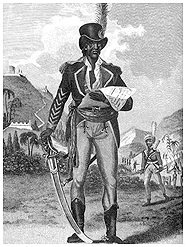 Jamaican planter Bryan Edwards, a first-hand observer of the events of 1791, states the slaves that resisted were unorganized, and new from Africa. " It is indeed true, that negro-rebellions have heretofore arisen in this and other islands of the West Indies, to which no such exciting causes contributed:-but it is equally certain, that those rebellions always originated among the newly-imported negroes only: many of whom had probably lived in a state of freedom in Africa, and had been fraudulently, or forcibly, sold into slavery by their chiefs. That cases of this kind do sometimes occur in the slave trade, I dare not dispute, and I admit that revolt and insurrection are their natural consequences." This account, written by a white planter, argues that resistance came from newly arrived slaves, not from the overwhelming injustices resented by all blacks. Newly arrived slaves did participate in the insurrection, but resistance and revolutionary ideas had been hidden in the souls of civilizations that perished. A Creole language and the religion of Vodun were built on Caribbean religions and gatherings in the Caribbean. These brought divided ethnic groups together in new unity. These were the tools of organization. Boukman, a maroon and voodoo priest conducted a meeting, in Creole, of the leaders to seal their ideas in August of 1791. "There Boukman gave the last instructions and, after Voodoo incantations and the sucking of the blood of a stuck pig, he stimulated his followers by a prayer spoken in Creole, which, like so much spoken on such occasions, has remained." About a week later the first uprising of black masses occurred. Jamaican planter Bryan Edwards, a first-hand observer of the events of 1791, states the slaves that resisted were unorganized, and new from Africa. " It is indeed true, that negro-rebellions have heretofore arisen in this and other islands of the West Indies, to which no such exciting causes contributed:-but it is equally certain, that those rebellions always originated among the newly-imported negroes only: many of whom had probably lived in a state of freedom in Africa, and had been fraudulently, or forcibly, sold into slavery by their chiefs. That cases of this kind do sometimes occur in the slave trade, I dare not dispute, and I admit that revolt and insurrection are their natural consequences." This account, written by a white planter, argues that resistance came from newly arrived slaves, not from the overwhelming injustices resented by all blacks. Newly arrived slaves did participate in the insurrection, but resistance and revolutionary ideas had been hidden in the souls of civilizations that perished. A Creole language and the religion of Vodun were built on Caribbean religions and gatherings in the Caribbean. These brought divided ethnic groups together in new unity. These were the tools of organization. Boukman, a maroon and voodoo priest conducted a meeting, in Creole, of the leaders to seal their ideas in August of 1791. "There Boukman gave the last instructions and, after Voodoo incantations and the sucking of the blood of a stuck pig, he stimulated his followers by a prayer spoken in Creole, which, like so much spoken on such occasions, has remained." About a week later the first uprising of black masses occurred.
Slaves had heard of the French Revolution and organized meetings to discuss their rights. James wrote, "As early as October 1789, in Fort Dauphin, one of the future centers of the San Domingo insurrection, the slaves were stirring and holding mass meetings in the forests at night. In isolated plantations there were movements. All were bloodily repressed. Revolutionary literature was circulating among them." Furthermore, some French soldiers arriving on San Domingo carried revolution sentiment to the blacks. " In March 1791,… the French soldiers, on landing at Port-au-Prince, had given the fraternal embrace to all Mulattoes and all Negroes, telling them that the Assembly in France had declared all men free and equal. At many places near Port-au-Prince the Negroes were seizing arms and rebelling."
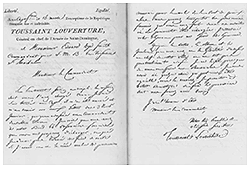 Organization of black rebels appeared around the island of San Domingo after the outbreak of August 1791. Gangs of rebels working in sugar plantations organized themselves into camps of revolutionaries. Oppressed workers now joined forces and organized as soldiers. "The slaves worked on the land, and, like revolutionary peasants everywhere, they aimed at the extermination of their oppressors. But working and living together in gangs of hundreds on the huge sugar-factories which covered the North Plain, they were closer to a modern proletariat than any group of workers in existence at the time." As forward progress was made camps were set up. "The revolters followed the same plan; they stationed camps in all the districts they had ravaged." Organization of black rebels appeared around the island of San Domingo after the outbreak of August 1791. Gangs of rebels working in sugar plantations organized themselves into camps of revolutionaries. Oppressed workers now joined forces and organized as soldiers. "The slaves worked on the land, and, like revolutionary peasants everywhere, they aimed at the extermination of their oppressors. But working and living together in gangs of hundreds on the huge sugar-factories which covered the North Plain, they were closer to a modern proletariat than any group of workers in existence at the time." As forward progress was made camps were set up. "The revolters followed the same plan; they stationed camps in all the districts they had ravaged."
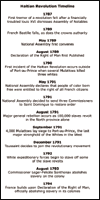 Resistance permeated the hearts of blacks, and was recapitulated and represented by a few slave leaders. The interests of the slaves became strategic goals in the hands of leaders. Men such as Toussaint, Francois, Biassou, Macaya, Dessalines, and Christophe had abolition in mind, and played roles of diplomats as well as military leaders. Toussaint was too careful to trust French politics, "…Because the French Revolution, being still in the hands of Liberals and moderates, was clearly bent on driving the blacks back to the old slavery." Toussaint’s distrust of politics may have been a political tool to gain support from the blacks. " In politics all abstract terms conceal treachery." Toussaint’s constant goal in any allegiance was the complete abolishment of slavery. As leaders such as Jean-Francois and Biassou disbanded, many rebels joined Toussaint in 1794. By 1800, Toussaint was commander in chief of all French forces on the island, and worked to secure the port of Santo Domingo. He set up an export oriented economy, and imposed a military dictatorship over the island. Before the betrayal, Toussaint had established his autonomy, led all the French forces, stricken Napoleon with grief, and helped organize a slave revolution. Resistance permeated the hearts of blacks, and was recapitulated and represented by a few slave leaders. The interests of the slaves became strategic goals in the hands of leaders. Men such as Toussaint, Francois, Biassou, Macaya, Dessalines, and Christophe had abolition in mind, and played roles of diplomats as well as military leaders. Toussaint was too careful to trust French politics, "…Because the French Revolution, being still in the hands of Liberals and moderates, was clearly bent on driving the blacks back to the old slavery." Toussaint’s distrust of politics may have been a political tool to gain support from the blacks. " In politics all abstract terms conceal treachery." Toussaint’s constant goal in any allegiance was the complete abolishment of slavery. As leaders such as Jean-Francois and Biassou disbanded, many rebels joined Toussaint in 1794. By 1800, Toussaint was commander in chief of all French forces on the island, and worked to secure the port of Santo Domingo. He set up an export oriented economy, and imposed a military dictatorship over the island. Before the betrayal, Toussaint had established his autonomy, led all the French forces, stricken Napoleon with grief, and helped organize a slave revolution.
The brutality of white plantation owners towards their slaves culminated in a deep- rooted sense of anguish and resistance among the oppressed. Slave organization began prior to any French Revolutionary ideas, through religion, language, and mass gatherings in woods. After the French Revolutionary legislation was passed it created an opportunity to abolish slavery in San Domingo. Leaders of the Haitian Revolution understood that the whites were now divided and confused, and assembled a revolution. There was one objective - complete abolition of slavery, and to achieve that goal these men and women were willing to challenge the most powerful nation at the time and won.
|
B., Account of the Insurrection of the Negroes in St. Domingo ( 1791 )
Garran Coulon , An Inquiry into the Causes of the Insurrection of the Negroes in the Island of San Domingo ( 1792)
Millet J.B., Account of the Insurrection of the Negroes in the Island of San Domingo.
Garran Coulon, Observations on the Insurrections of the Negroes in the Island of St. Domingo.
Edwards Bryan, An Historical Survey of the Island of Saint Domingo Together with an Account of the Maroon Negroes in the Island of Jamaica, and a History of the War in the West Indies in 1793 and 1794, ( London 1801).
James C.L.R., The Black Jacobins-Toussaint L'Ouverture and the San Domingo Revolution, (Vintage Books, New York 1989). |

 |





